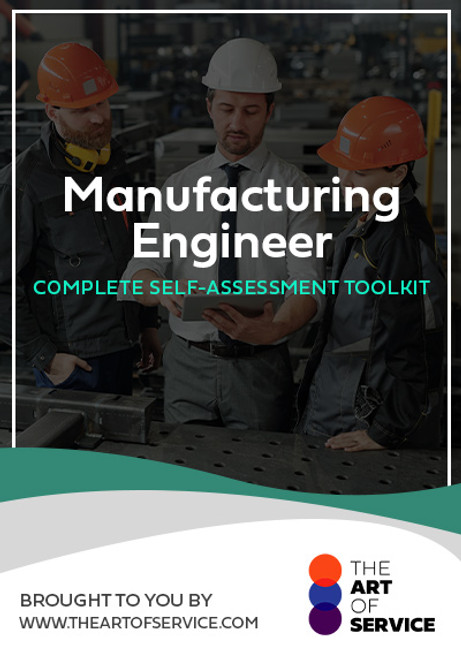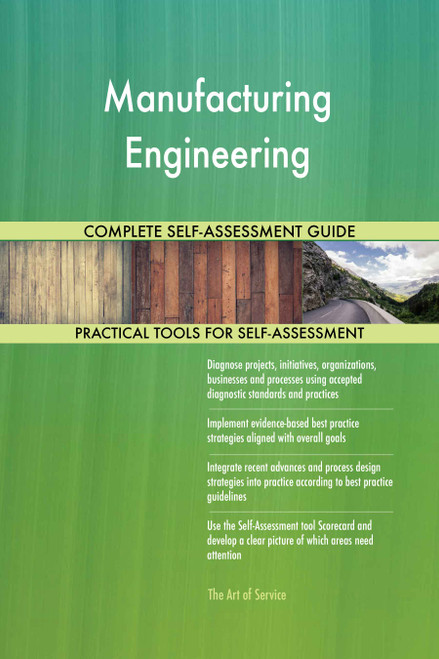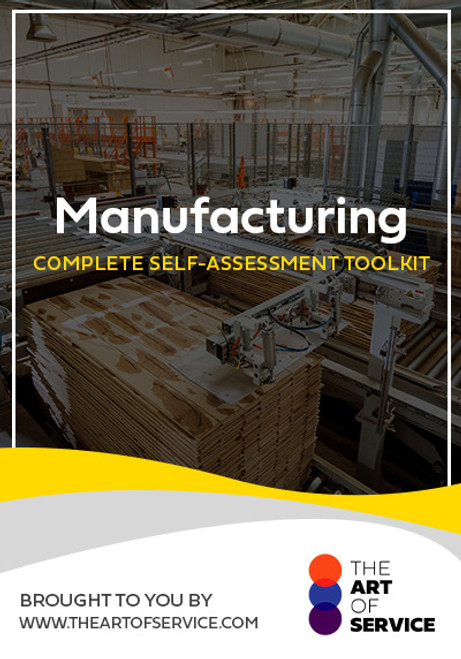Collaborate with stakeholder teams like Manufacturing Engineering, Packaging Engineering, Logistics, Supply Chain teams, IT systems Developers, and Material Planning to prioritize and maximize Operational Efficiency of Production Control Operations team.
More Uses of the Manufacturing Engineering Toolkit:
- Provide Technical Support to manufacturing equipment and processes by interacting with production and maintenance personnel to identify, diagnose, and correct process problems.
- Coordinate: partner with production technicians or other departments to enhance Manufacturing Processes, troubleshoot issues and provide technical guidance.
- Arrange that your organization serves on technical teams to accomplish organization objectives for product supply, quality, cost, new product introduction, and sustaining Manufacturing Engineering activities.
- Manage work with team members to solve customer issues related to quality and design; solve issues related to the process and equipment and implement changes to production lines.
- Initiate: partner with Manufacturing Engineers to develop the Data Integrations that enable visibility into manufacturing production, equipment, processes, and product tests.
- Ensure all processes are set up, operating and monitored in accordance with the requirements set forth by the Manufacturing Engineering and customer, and support a smooth product transition into manufacturing.
- Ensure your corporation provides engineering support in planning, financial justification, start up activities, scale up processes, implementation, and Process Improvements.
- Warrant that your organization participates in installation, troubleshooting, failure investigations, and Corrective Action of material, process, and mechanical problems.
- Establish that your group complies; cross functional and cross organization partnership with Product Quality, Manufacturing Engineering, purchasing, sourcing, new product introduction, and logistics teams to support Customer Success.
- Drive: partner with programs and customer base to identify technical capability and hardware needs to ensure efficient, high quality results.
- Manage work with Product Development engineering and Manufacturing Engineering to translate design requirements into manufacturing requirements to achieve Design for Manufacturability.
- Ensure your organization complies; cross functional and cross organization partnership with Product Quality, order fulfillment, Manufacturing Engineering, sourcing, new product introduction, and logistics teams to support Customer Success.
- Collaborate with production control and Manufacturing Engineering teams to identify and resolve ready work constraints that are impeding critical path flow of operations.
- Establish that your group develops, implements, and maintains methods, operation sequence and processes in the fabrication of parts, components, sub assemblies and final assemblies.
- Make sure that your team supports manufacturing and provides manufacturing with tools and engineering support to implement new products into production and in the resolution of manufacturing issues.
- Liaise with engineering, purchasing, operations, Manufacturing Engineering, to achieve On Time Delivery at optimum cost with optimum inventory levels.
- Manage work with the Project Teams to identify new process capabilities, perform product validation and facilitate transition from development to production release.
- Manage work with Product Management/product engineering on concepts to develop new technologies and/or minimize impact to existing equipment.
- Lead: clearly understand existing processes to provide support for manufacturing process Technology Roadmap and Operations Strategy, and represent Manufacturing Engineering on complaint handling unit and Change Control board meetings.
- Oversee: work closely with production operators, supervisors, and other functional teams to continually improving product flow and quality.
- Manage work with the core team (Design, Quality, Supplier Quality and Packaging Engineering) on new Product Development and implementation.
- Prioritize daily work and ongoing projects for the Manufacturing Engineering department to ensure alignment with overall strategy for plant and to deliver on customer commitments.
- Confirm your organization assures that review to ensure employee safety are completed during process and that a review for safety takes place with any process and/or equipment change.
- Initiate: work concurrently with Manufacturing Engineering, Manufacturing and Quality Engineering groups in starting up production of new and improved products.
- Troubleshoot existing products and processes to recommend and develop/design engineering solutions to address capacity, cost, and quality issues.
- Make sure that your strategy coordinates production activities with other functions as material, marketing, new Product Development, Customer Service, Manufacturing Engineering, inspection, and the like.
- Develop, implement, and manage Process Improvement projects related to improving equipment reliability standardizing your preventive maintenance program, and developing your workforce.
- Confirm your operation interacts with Manufacturing Engineers, supplier Quality Engineers and customer Quality Engineers to drive improvement activities and ensure product and processes meet or exceed customer expectations.
- Arrange that your business supports production personnel by resolving process and material related quality problems in support of the various manufacturing departments.
- Manage work with Quality Control and Manufacturing Engineers on identified issues related to design, components, processes, documentation, etc.
Save time, empower your teams and effectively upgrade your processes with access to this practical Manufacturing Engineer Toolkit and guide. Address common challenges with best-practice templates, step-by-step Work Plans and maturity diagnostics for any Manufacturing Engineer related project.
Download the Toolkit and in Three Steps you will be guided from idea to implementation results.
The Toolkit contains the following practical and powerful enablers with new and updated Manufacturing Engineer specific requirements:
STEP 1: Get your bearings
Start with...
- The latest quick edition of the Manufacturing Engineer Self Assessment book in PDF containing 49 requirements to perform a quickscan, get an overview and share with stakeholders.
Organized in a Data Driven improvement cycle RDMAICS (Recognize, Define, Measure, Analyze, Improve, Control and Sustain), check the…
- Example pre-filled Self-Assessment Excel Dashboard to get familiar with results generation
Then find your goals...
STEP 2: Set concrete goals, tasks, dates and numbers you can track
Featuring 999 new and updated case-based questions, organized into seven core areas of Process Design, this Self-Assessment will help you identify areas in which Manufacturing Engineer improvements can be made.
Examples; 10 of the 999 standard requirements:
- How do you go about comparing Manufacturing Engineer approaches/solutions?
- How do you hand over Manufacturing Engineer context?
- What is the scope?
- Are procedures documented for managing Manufacturing Engineer risks?
- Does the problem have ethical dimensions?
- How do you focus on what is right -not who is right?
- Who has control over resources?
- What is measured? Why?
- What are the Manufacturing Engineer tasks and definitions?
- What sources do you use to gather information for a Manufacturing Engineer study?
Complete the self assessment, on your own or with a team in a workshop setting. Use the workbook together with the self assessment requirements spreadsheet:
- The workbook is the latest in-depth complete edition of the Manufacturing Engineer book in PDF containing 994 requirements, which criteria correspond to the criteria in...
Your Manufacturing Engineer self-assessment dashboard which gives you your dynamically prioritized projects-ready tool and shows your organization exactly what to do next:
- The Self-Assessment Excel Dashboard; with the Manufacturing Engineer Self-Assessment and Scorecard you will develop a clear picture of which Manufacturing Engineer areas need attention, which requirements you should focus on and who will be responsible for them:
- Shows your organization instant insight in areas for improvement: Auto generates reports, radar chart for maturity assessment, insights per process and participant and bespoke, ready to use, RACI Matrix
- Gives you a professional Dashboard to guide and perform a thorough Manufacturing Engineer Self-Assessment
- Is secure: Ensures offline Data Protection of your Self-Assessment results
- Dynamically prioritized projects-ready RACI Matrix shows your organization exactly what to do next:
STEP 3: Implement, Track, follow up and revise strategy
The outcomes of STEP 2, the self assessment, are the inputs for STEP 3; Start and manage Manufacturing Engineer projects with the 62 implementation resources:
- 62 step-by-step Manufacturing Engineer Project Management Form Templates covering over 1500 Manufacturing Engineer project requirements and success criteria:
Examples; 10 of the check box criteria:
- Cost Management Plan: Eac -estimate at completion, what is the total job expected to cost?
- Activity Cost Estimates: In which phase of the Acquisition Process cycle does source qualifications reside?
- Project Scope Statement: Will all Manufacturing Engineer project issues be unconditionally tracked through the Issue Resolution process?
- Closing Process Group: Did the Manufacturing Engineer project team have enough people to execute the Manufacturing Engineer project plan?
- Source Selection Criteria: What are the guidelines regarding award without considerations?
- Scope Management Plan: Are Corrective Actions taken when actual results are substantially different from detailed Manufacturing Engineer project plan (variances)?
- Initiating Process Group: During which stage of Risk planning are risks prioritized based on probability and impact?
- Cost Management Plan: Is your organization certified as a supplier, wholesaler, regular dealer, or manufacturer of corresponding products/supplies?
- Procurement Audit: Was a formal review of tenders received undertaken?
- Activity Cost Estimates: What procedures are put in place regarding bidding and cost comparisons, if any?
Step-by-step and complete Manufacturing Engineer Project Management Forms and Templates including check box criteria and templates.
1.0 Initiating Process Group:
- 1.1 Manufacturing Engineer project Charter
- 1.2 Stakeholder Register
- 1.3 Stakeholder Analysis Matrix
2.0 Planning Process Group:
- 2.1 Manufacturing Engineer Project Management Plan
- 2.2 Scope Management Plan
- 2.3 Requirements Management Plan
- 2.4 Requirements Documentation
- 2.5 Requirements Traceability Matrix
- 2.6 Manufacturing Engineer project Scope Statement
- 2.7 Assumption and Constraint Log
- 2.8 Work Breakdown Structure
- 2.9 WBS Dictionary
- 2.10 Schedule Management Plan
- 2.11 Activity List
- 2.12 Activity Attributes
- 2.13 Milestone List
- 2.14 Network Diagram
- 2.15 Activity Resource Requirements
- 2.16 Resource Breakdown Structure
- 2.17 Activity Duration Estimates
- 2.18 Duration Estimating Worksheet
- 2.19 Manufacturing Engineer project Schedule
- 2.20 Cost Management Plan
- 2.21 Activity Cost Estimates
- 2.22 Cost Estimating Worksheet
- 2.23 Cost Baseline
- 2.24 Quality Management Plan
- 2.25 Quality Metrics
- 2.26 Process Improvement Plan
- 2.27 Responsibility Assignment Matrix
- 2.28 Roles and Responsibilities
- 2.29 Human Resource Management Plan
- 2.30 Communications Management Plan
- 2.31 Risk Management Plan
- 2.32 Risk Register
- 2.33 Probability and Impact Assessment
- 2.34 Probability and Impact Matrix
- 2.35 Risk Data Sheet
- 2.36 Procurement Management Plan
- 2.37 Source Selection Criteria
- 2.38 Stakeholder Management Plan
- 2.39 Change Management Plan
3.0 Executing Process Group:
- 3.1 Team Member Status Report
- 3.2 Change Request
- 3.3 Change Log
- 3.4 Decision Log
- 3.5 Quality Audit
- 3.6 Team Directory
- 3.7 Team Operating Agreement
- 3.8 Team Performance Assessment
- 3.9 Team Member Performance Assessment
- 3.10 Issue Log
4.0 Monitoring and Controlling Process Group:
- 4.1 Manufacturing Engineer project Performance Report
- 4.2 Variance Analysis
- 4.3 Earned Value Status
- 4.4 Risk Audit
- 4.5 Contractor Status Report
- 4.6 Formal Acceptance
5.0 Closing Process Group:
- 5.1 Procurement Audit
- 5.2 Contract Close-Out
- 5.3 Manufacturing Engineer project or Phase Close-Out
- 5.4 Lessons Learned
Results
With this Three Step process you will have all the tools you need for any Manufacturing Engineer project with this in-depth Manufacturing Engineer Toolkit.
In using the Toolkit you will be better able to:
- Diagnose Manufacturing Engineer projects, initiatives, organizations, businesses and processes using accepted diagnostic standards and practices
- Implement evidence-based best practice strategies aligned with overall goals
- Integrate recent advances in Manufacturing Engineer and put Process Design strategies into practice according to best practice guidelines
Defining, designing, creating, and implementing a process to solve a business challenge or meet a business objective is the most valuable role; In EVERY company, organization and department.
Unless you are talking a one-time, single-use project within a business, there should be a process. Whether that process is managed and implemented by humans, AI, or a combination of the two, it needs to be designed by someone with a complex enough perspective to ask the right questions. Someone capable of asking the right questions and step back and say, 'What are we really trying to accomplish here? And is there a different way to look at it?'
This Toolkit empowers people to do just that - whether their title is entrepreneur, manager, consultant, (Vice-)President, CxO etc... - they are the people who rule the future. They are the person who asks the right questions to make Manufacturing Engineer investments work better.
This Manufacturing Engineer All-Inclusive Toolkit enables You to be that person.
Includes lifetime updates
Every self assessment comes with Lifetime Updates and Lifetime Free Updated Books. Lifetime Updates is an industry-first feature which allows you to receive verified self assessment updates, ensuring you always have the most accurate information at your fingertips.







